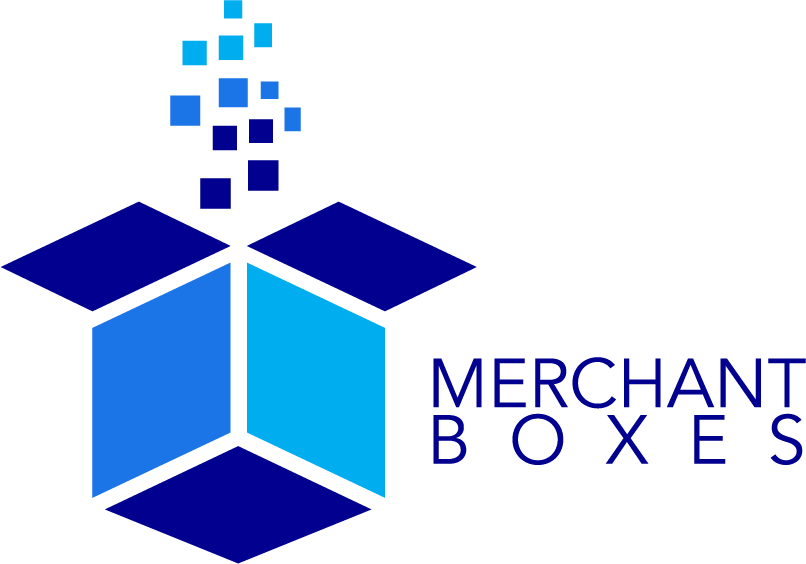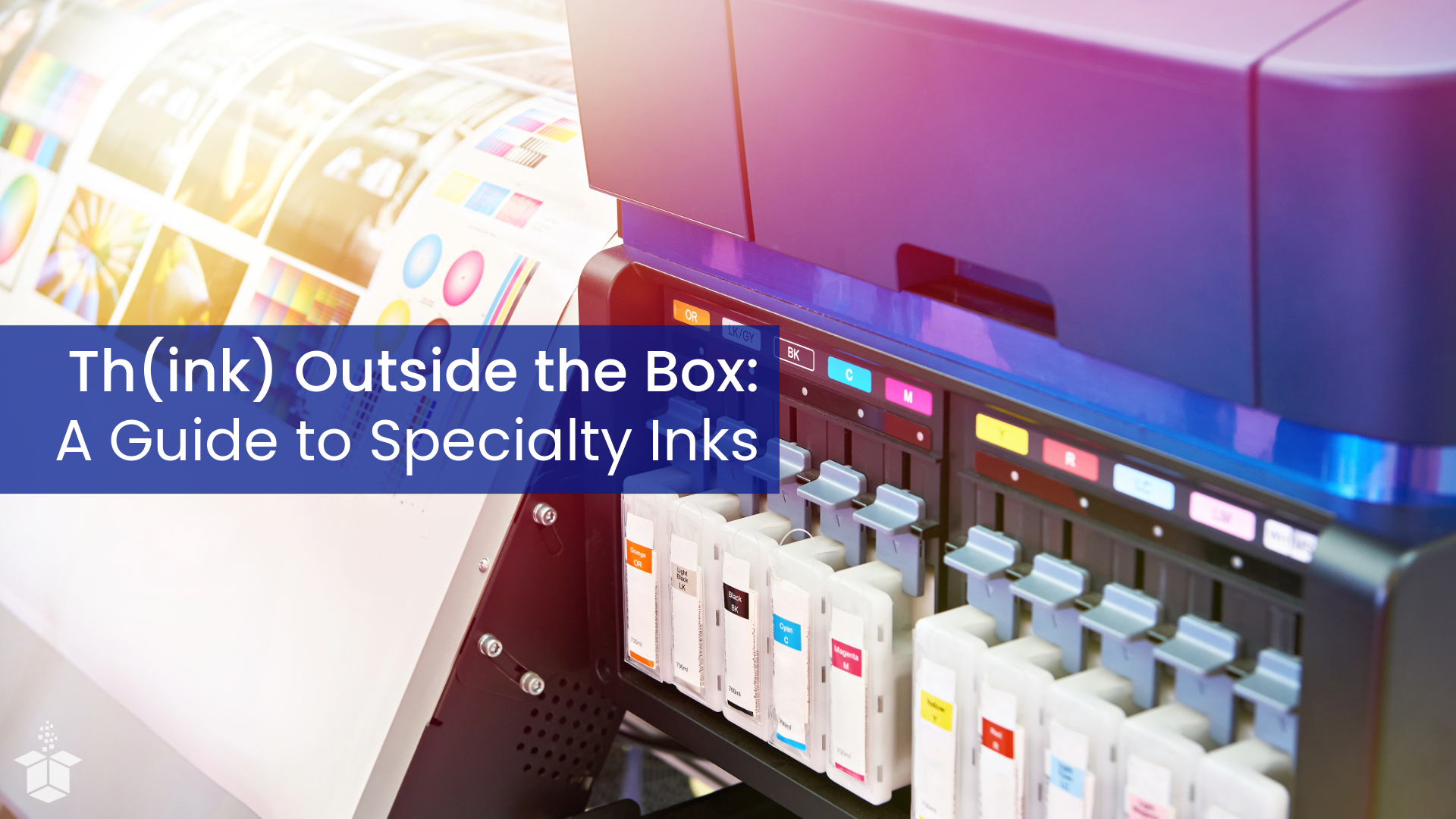Th(ink) Outside the Box: A Guide to Specialty Inks
Let’s be real, standard CMYK printing gets the job done and sometimes that is all you need! But when your packaging needs to wow, surprise, or even smell amazing (yep, we’ll get there), that’s when specialty inks come into play.
From glowing graphics to heat-sensitive secrets, here’s your all-access pass to the wonderful world of specialty inks and how they can transform your packaging from “meh” to “memorable.”
Metallic Inks: It’s Time to Shine
What They Are
Metallic inks are infused with tiny metal flakes (think aluminum or bronze) giving them a shimmery, reflective finish. They are available in classic colors like gold, silver, and copper, but also as bold hues like metallic blue or ruby red.
How They Work
The metal particles reflect light, creating that iconic shine. Unlike foil stamping, metallic inks are printed like regular ink, making them more versatile for coverage and detail.
How to Use Them
Add a luxe touch to premium products (think cosmetics, alcohol, jewelry).
Highlight logos or key elements for added pop.
Combine with matte textures for contrast that turns heads.
Shiny Example:
A craft brewery could use metallic bronze ink on textured black cans to create a vintage, high-end feel without the need for actual foil.
Fluorescent & Neon Inks: Bold, Bright, and Impossible to Ignore
What They Are
Fluorescent inks absorb UV light and re-emit it, resulting in eye-popping intensity. Neon inks offer similarly bold tones but without the same UV reactivity.
How They Work
These inks glow under black light but also stand out under regular lighting due to their vibrant pigment concentration.
How to Use Them
Grab attention on retail shelves.
Add fun, playful accents for youthful or party-focused brands.
Perfect for limited editions or seasonal designs (think summer or festival packaging).
Bright Idea:
A sneaker brand could launch a neon-laced box for a retro ‘90s-inspired release with fluorescent green logos on a matte white background, impossible to miss.
Thermochromic Ink: Heat-Activated Magic
What It Is
This ink reacts to temperature changes, revealing or hiding designs depending on how warm or cold it gets. Think mugs that reveal patterns when filled with hot coffee, but on packaging.
How It Works
The ink contains leuco dye pigments that change molecular structure when exposed to heat or cold, altering their visible color. This ink can be designed to fade, darken, or switch between colors, depending on the application. Pretty cool, right?
How to Use It
Create interactive packaging that changes with touch.
Reveal hidden messages (like a “Thank you” or promo code).
Ideal for temperature-sensitive goods—coffee, tea, frozen treats.
Hot Take:
A drink brand that has products better served cold uses thermochromic ink on its bottle or can labels to show an icon or logo when the product is served at the perfect chilled temperature.
A coffee shop could use thermochromic ink on its cups to show that the drink inside is still hot and ready for consumption.
Glow-in-the-Dark Ink: Charge It Up, Light It Up
What It Is
An ink that absorbs light and emits it in the dark. Spooky? Maybe. Cool? Absolutely.
How It Works
Phosphorescent pigments “charge” under light exposure and then glow in the dark—no power needed. Most phosphorescent pigments have a crystal structure made up of zinc sulfide with copper added as the activator. When exposed to light, these crystals absorb the light and then slowly emit it later on, which is what makes it glow.
How to Use It
Great for kids’ products, game packaging, or Halloween promos.
Add a surprise layer that only appears in the dark.
Can pair with standard print for a multi-stage reveal.
Glowing Example:
A board game uses glow-in-the-dark ink on the outer box that lights up the game’s logo in the dark, enhancing its mystery theme.
Scented Inks: Scratch, Sniff, Smile
What It Is
These inks are infused with micro-encapsulated fragrances that release when scratched or rubbed and can last for a while depending on how often the ink is activated. These inks can be used with a variety of fragrances from floral or fruity, to food or outdoor scents.
How It Works
The scent is encapsulated in tiny bubbles within the ink. Rubbing or scratching breaks them open, releasing the fragrance.
How to Use It
Showcase scents for candles, perfumes, or even food items.
Elevate the unboxing experience.
Tie into seasonal promotions (peppermint for holidays, citrus for summer).
Scent-sational Use Example:
A tea brand prints a scratch-and-sniff section on its boxes that lets customers sample the aroma before opening the pack. Pretty genius if you ask me.
UV Reactive Inks: Now You See It… Under Blacklight
What They Are
This ink is invisible under normal light, but glows or reveals details when exposed to UV (blacklight).
How They Work
UV inks react with ultraviolet light, either fluorescing or becoming visible under certain wavelengths.
How to Use Them
Add secret messages or authentication marks.
Create playful or limited-edition effects that only show under blacklights.
Great for promotions, nightlife brands, or collectible packaging.
Undercover Example:
A music festival merch box includes UV ink patterns that only appear when the included UV flashlight is used, and now the packaging is an interactive element.
Bonus Inks Worth Mentioning
If you’re already hooked, here are a few honorable mentions you might want to explore:
Chalkboard Ink: Writable with chalk—ideal for interactive or customizable packaging.
Photochromic Ink: Changes color in sunlight (UV-reactive, but daylight-specific).
Conductive Ink: Used in smart packaging for touch-based interactivity (like triggering audio or digital content via NFC).
Why Specialty Inks Matter
Beyond looking cool, specialty inks offer serious strategic advantages:
Differentiation – In a sea of sameness, a glowing, scratch-and-sniff, or color-changing package stands out.
Engagement – Inks that react to touch, light, or temperature invite people to interact.
Memorability – Sensory and visual surprises stick in the mind—and the shopping cart.
Final Splash
Whether you want to evoke luxury, nostalgia, surprise, or just have a little fun, specialty inks are the secret sauce that can bring your packaging to life. They’re not just about decoration—they’re about experience. And in a world of endless options, experience sells.
So... what will your packaging say when it heats up, glows in the dark, or releases a burst of vanilla? Time to get creative.
Want help integrating specialty inks into your packaging? Let’s make your brand shine, sizzle, and maybe even sparkle.








